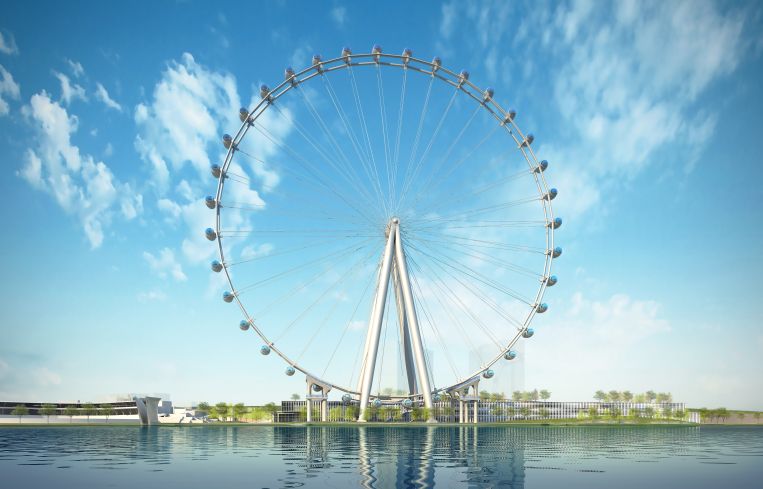Plans to Build New York Wheel Scrapped
412 EB-5 foreign investors are now in jeopardy of losing future US residency status
By Nicholas Rizzi October 23, 2018 3:03 pm
reprints
The New York Wheel won’t spin on Staten Island.
After years of delays, lawsuits and ballooning costs, developers of the Wheel announced today they officially pulled the plug on the 630-foot-tall observation wheel planned to take over the borough’s waterfront, the Staten Island Advance first reported.
“After years of planning, the developers of the New York Wheel announce, with great disappointment, that the dream of building a world-class attraction in Staten Island will unfortunately not come to fruition,” Cristyne Nicholas, a spokeswoman for the New York Wheel, said in a statement.
The announcement comes weeks after The Wall Street Journal reported investors Lloyd Goldman and Jeffrey Feil pleaded with the city to support a tax-exempt bond issue to get the project back on track with the threat that they would have to sell the giant legs of the project sitting in a Brooklyn terminal.
In 2016, developers estimated the Wheel would cost $580 million to finish, but WSJ reported this September that the cost grew to nearly $1 billion.
The Wheel’s cancelation puts in jeopardy the 412 foreign investors who put up a total of $206 million for the Wheel’s completion to qualify for permanent residency through the EB-5 program.
CanAm Enterprises, which arranged the EB-5 financing, said in a statement it was “disappointed” about the news but believed enough work had been done to satisfy the EB-5 requirements.
“This project came very close to completion and had already fulfilled all requirements as defined by the EB-5 program,” Tom Rosenfeld, the president and CEO of CanAm, said in a statement. “As a secured creditor, we also expect to enforce our rights and remedies including, among other things, in the collateral pledged to secure our loan.”
Michael Gibson, the founder of investment advisory firm USAdvisors, said there have been instances where investors of unfinished projects still qualified for the EB-5 program. But for the Wheel investors it’s not cut and dried.
“It would depend really on how much work was done and the evidence they submitted for the application,” Gibson said. “Because of the delays and the lack of capital expenditure [in the Wheel], there’s a good chance that a number of investors will not get their conditions approved.”
Local elected officials who backed the project—hopeful it would increase waterfront access in the neighborhood and add a new park—called the Wheel’s cancellation a “blow” to the neighborhood.
“The developer’s inability to complete the project is a deep disappointment for me and a blow to my district, as is the city’s refusal to issue bonds at no cost or risk to taxpayers, denying Staten Islanders needed amenities and a vision promised years ago,” Councilwoman Debi Rose, who represents the North Shore of Staten Island, said in a statement. “I will continue fighting to ensure that whatever goes in this space will bring us the same amenities that the New York Wheel would have: public open space, waterfront access and economic development.”
The Wheel was set to spin next to the under-construction Empire Outlets, set to be the only outlet mall in the city when it opens next year. When asked about the closing of its neighboring project, a spokesman for Empire Outlets touted, “Empire Outlets is now poised to become one of the nation’s top outlet centers—and fast-growing interest in Empire Outlets from international tourism officials has shown that Staten Island’s revitalized North Shore is already becoming a world-class destination.”
The New York Wheel project was announced by then-Mayor Michael Bloomberg in 2012 to take over a parking lot adjacent to the St. George Ferry Terminal and aimed to be the largest Ferris wheel in the world. It was eventually approved by the city in 2013 and broke ground in 2015.
Despite constant delays to the project, developers remained optimistic that the Wheel would take over Staten Island’s waterfront.
“I would challenge anybody who doesn’t believe to come down here and look at the $250 million we have in the ground,” Rich Marin, the CEO of New York Wheel LLC until January, told DNAinfo in 2016. “We’re either delusional or something if we don’t think it’s real at this point.”
However, the New York Wheel canned contractor Mammoet-Starnet from the project in 2017, stalling work on the project indefinitely and leading to a long legal battle. The developer hired a new contractor later last year and developers reached out to the city to support a $380 million bond sale to get them through the project, but Mayor Bill de Blasio said that he didn’t think the project was “economically viable” enough to warrant it, the Advance reported.
After six years of planning, all the Wheel will leave behind is about 8,000 cubic feet of concrete foundation, four 90-ton pedestals that were to hold the legs and an 820-space parking garage.


